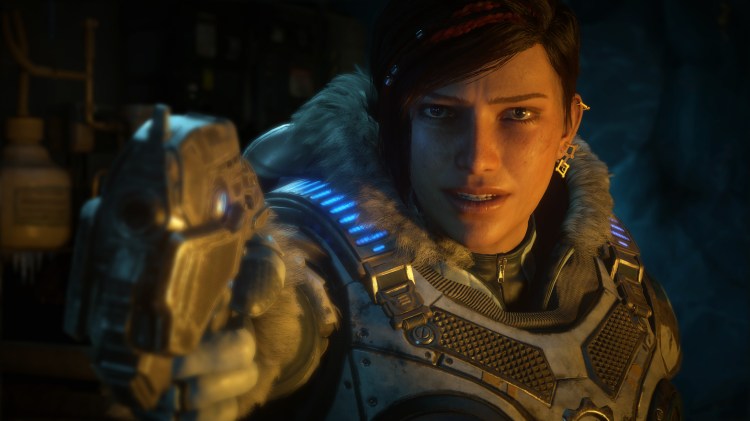Rod Fergusson, studio head of The Coalition, went out on a limb recently when he said that Gears of War 5 is the finest game in the Gears saga, which began with Epic Games’ first Gears title in 2006. Microsoft got the rights to Gears in 2014, and it launched The Coalition studio in Vancouver, Canada. We have seen six Gears games so far, and this one is a good one.
I played the full game on Windows 10 laptop and reviewed it. Afterward, I interviewed Fergusson, who has been with the series since the beginning, about the choices that the developers made. I think that Fergusson was right to say it is one of the finest games in the series.
We talked about how The Coalition tried to make the game more approachable because the team knew that many fresh players would be coming into the series via the Xbox Game Pass. We also talked about the shift to Kait as the main character, the diversity of the series, the battle with a fearsome boss dubbed The Matriarch, the big kaiju-like beast in the game, the ongoing destruction of Sera, the design of the robot Jack, and the challenge of balancing both comedy and tragedy in the same story.
Here’s an edited transcript of our interview. Beware, there are some spoilers in this interview. Gears 5 debuted on September 6 for players with the Ultimate Edition. It debuts on Xbox One and Windows for standard edition players on Tuesday.
June 5th: The AI Audit in NYC
Join us next week in NYC to engage with top executive leaders, delving into strategies for auditing AI models to ensure fairness, optimal performance, and ethical compliance across diverse organizations. Secure your attendance for this exclusive invite-only event.

Above: Rod Fergusson is studio head of The Coalition, maker of Gears of War 5.
GamesBeat: Some big days ahead for you.
Rod Fergusson: Yep, we’re down to it now. The next couple days will be a lot of fun.
GamesBeat: I hear you tried hard to make this game more approachable. Could you describe how you went about that?
Fergusson: It was one of those things — when you realize what’s going to happen with Game Pass, millions of people are going to have access to the game without any sort of barrier. They don’t have to put down $60 to play it. We wanted to make sure we created a game that, even though it’s the fifth in the franchise, it was the most approachable, so that when new players came in, we could welcome them in a meaningful way.
We did a bunch of stuff. One thing we did, we really pulled out our tutorial into a boot camp, so that new players could come in at their own pace and play through to learn the mechanics. Traditionally we tried to put it in the game, and it doesn’t — you can’t be super explicit about learning, because you’re trying to do it in the context of the story. The story suffers because you’re taking time to do learning. We felt it would be better to create the boot camp that you could go to and learn how to take cover, how to blind-fire, how to throw grenades, all these things, and do it at your own pace. You can repeat it if you want to. That way, when you go into multiplayer or campaign, you’re prepared.
You go through a lesson, and then the lesson will — it’s done in the context of Baird and Del working together. With each lesson Baird will ask you if you’re ready to move on. Then you can say yes or no. You can decide if you want to redo a tutorial or move forward.
The other part we looked at was multiplayer. Historically multiplayer in Gears has been seen as hardcore. People come in and do a lot of wall-bouncing, fast-moving people with shotguns, and you get shot in the face five times. Maybe it’s not your best first experience. We created a new mode called Arcade, which people got to try in the tech test. We slowed down the movement. We added passive abilities. Almost every gun can do headshots.

Above: JD, the son of Marcus Fenix.
We made it not about shotguns, basically. It’s about weapon variety. Each character has their own weapon upgrade path, and as you play and get eliminations, whether you help somebody or down somebody or revive somebody, you can use those eliminations to buy a new weapon and upgrade. You get these fun fights between rifles versus rocket launchers or melee weapons. It’s not just a shotgun-fest. We saw in the tech test that the feedback was what we wanted. People said, “I don’t play a lot of Gears multiplayer, but now that I’ve played Arcade it’s a lot of fun. I’ll play that a lot.” That’s been awesome.
With Jack, our robot, you can play him in the campaign and you can play him in Horde. He’s a different style of play. It’s not a cover-taking character that uses pixel precision to shoot a gun. He floats above cover. He supports the other characters. You tend to have area of effect. His weapons auto-aim or attack an area. It doesn’t require the fidelity of being able to pixel-hunt. It’s another way to welcome new players. If you have someone who’s a long-time Gears player and they want to play with someone who’s new to it, you can bring them in through Jack. Jack is just fun. I’m a support player. I love the idea of helping others and being able to heal on the fly or revive people or repair fortifications. Even for highly skilled players, Jack is super fun. He’s critical to the play experience.
We also added a bunch of accessibility options. We worked with the Gaming for Everyone division here at Microsoft. We had an inclusive design sprint. We brought in subject matter experts. We looked at what the community is saying about what they need. We did things like improving our subtitling, so now you can change the font size. There’s a background. It tells you the character’s name when they talk. You can remove camera shake. You can remove controller shake. You can have single-stick controls if you need them. You can, for the first time ever, remap every control. Every button can be mapped somewhere else. That helps things like the adaptive controller, where remappability is what makes that work. We wanted to make sure we supported that.
GamesBeat: You mentioned at Gamescom that you felt like this was your finest Gears of War game. What did you mean by that, as far as how your team got very enthusiastic about this one?
Fergusson: In terms of the quality of offering — every Gears game I ship is special, because of the team I work with. Gears one was super special the first time, and so on. But 5 has been — just the quality of the team and the quality of the game, I’m really proud of the fact that there’s so much value in it. It’s a five-in-one, having the biggest campaign we’ve ever had, the deepest Horde we’ve ever had, 11 competitive modes in versus. We have this new co-op mode, Escape. We have a map builder on top of that supporting Escape at launch, and post-launch you’ll be able to build maps for Horde and Versus.
When you look at the quality of the offering and the quality of the story — we’re telling an interesting story at a really big scale. The quality of the experience — we’ve changed a lot of things in terms of the way the gunplay works. It’s not using the same sort of mechanics that were more — the reticle is more precise. The inaccuracy is in the recoil, not in the spray. You can learn the weapons. Each weapon has a personality.
There’s just a quality of execution and a quality in the offering that I’m really proud of. We work very hard at the Coalition, and we’ve built a reputation. We say what we do and we do what we say. We focus on quality of execution. That’s why one of our awards inside the company is the GSD award, the “Get Shit Done” award. We really value execution at the Coalition, as a culture. If you look across all five different pieces inside the box, I think this is the best Gears yet.
GamesBeat: I felt like the shooting was better. I’m not exactly sure why. But I did use the whole wide array of guns that you guys put in the game. You’re right that normally, if I go online, I’d have to use the shotgun. Hopefully that part is changing. But the gunplay variety was very good this time. I liked the freeze gun. That was very useful.
Fergusson: Yeah, yeah. Jack mixes up the gunplay too. In the previous Gears games, the only way you could interact with the world was with your gun. Now Jack can make you invisible or heal you or put up a barrier. It adds another layer to the combat.
I also just think the responsiveness — this is the first game on Xbox One X, where you don’t have to make a choice between pretty and performance. We don’t have to decide whether we want 4K or 60fps. This is the first campaign running at 60, and it’s running at 60 in 4K. It looks good and it feels responsive, which I love.
GamesBeat: What about Kait as a main character? How did you look at that? Does it make the game feel different, that she’s in the lead?
Fergusson: It definitely feels different, in a good way. The big thing for us was just coming down to quality of storytelling. We looked at where the story was going as we transitioned from 4 to 5, and we felt like this is really Kait’s story. It was kind of Kait’s story in 4. You were helping her save her mom. In 5 it was even more so, about what she was going through. We felt the story would be more impactful if it was from her perspective, if you got to feel it, as opposed to watching it. If you were just on the outside watching her go through things, it wouldn’t be as impactful as being her, you yourself going through it.
It allowed us to do some fun stuff with perspective. If you play as Kait, you’ll see things that you won’t see if you play as Del or Jack. Being able to live Kait’s perspective means you get to see things differently.
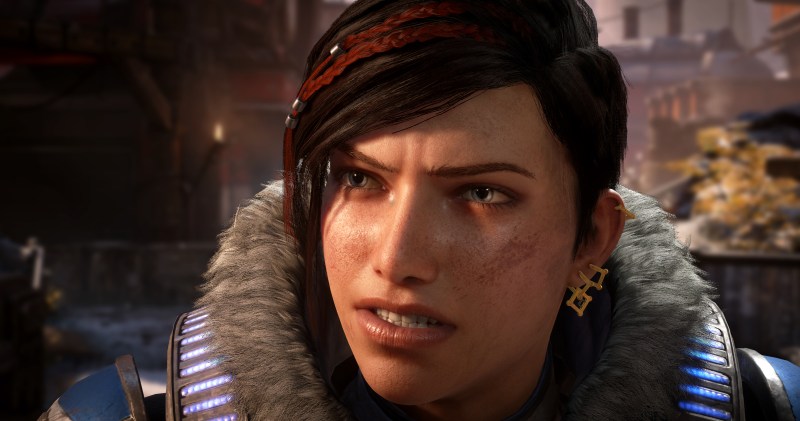
Above: Gears 5 Kait Hero Close Up
GamesBeat: In some ways it seems like you guys held back from some of the plot points or story because this is the second in a three-part story.
Fergusson: [laughs] We’re trying to get out of the trilogy mindset. The word I like now is “saga.” Just the idea that we don’t want to limit ourselves to a beginning, middle, and end, one-two-three thing. “Oh, this is the Empire Strikes Back game.” That kind of thing. For us it’s just about where the story can take us and what stories we can tell. This is just a continuation of the saga.
It’s nice to have a young set of characters, instead of being in their mid-40s. It gives us a lot of head room in terms of where we can go. We wanted these younger characters so that we could transform them over time. With Marcus and Delta Squad, they were set in their ways. The world changed around them, but they didn’t really change. Now, as you see with JD in this game, their experiences can change them and transform them. That’s what we want to lean into, to have that happen as we move forward.
GamesBeat: You wanted to make this a Gears for a new generation of players, do you think?
Fergusson: We wanted to keep the people who’ve been playing. Much like Star Trek and the Next Generation — I jokingly call this Gears: The Next Generation. It was just a way to take a different approach to the storytelling and the character development. Previously we had very iconic characters. You understood them immediately in two words. Sports hero, anti-hero, science guy. They were very quick, iconic archetypes.
When you look at modern storytelling, things are more grey. They’re a bit more nuanced than that. We wanted to have characters that had more nuance to them, so that we could go different places with them. It means they’re not quite as instantly recognizable out of the gate, what sort of personality and archetype they fit into. But it makes for a more interesting, nuanced, and sophisticated journey.
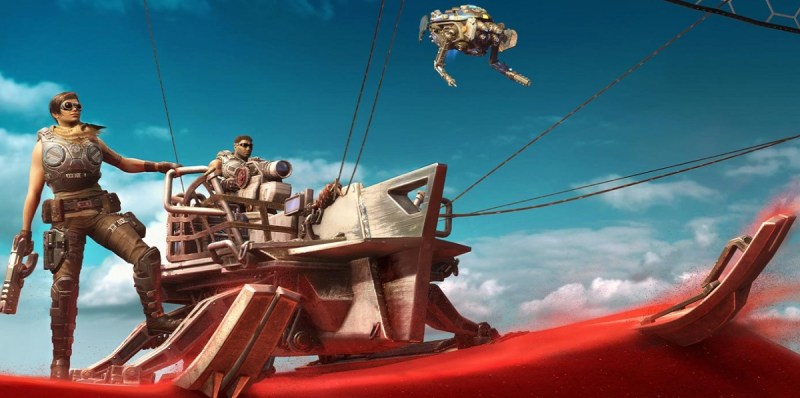
Above: Gears 5’s skiff gets you around the ice and sands.
GamesBeat: I did feel that it was a complete story, but there were probably two points where I felt like you held back. One was more obviously a conflict with her mother, the ultimate boss. It seems like that’s postponed for another day. And then the conflict with the COG as well, where Kait has this dual nature, and they’re not sure whether to trust her. It almost felt like they were on the verge of mistrusting her, but they never really got to that point. I don’t know if that’s something that’s held back in way.
Fergusson: Those are things that we wanted to — we like to create negative space, in the sense of places we can go and opportunities to explore. Part of what I like about Gears games — this is the first Gears we ever did with time elapsing. Normally a Gears game is about 24 or 36 hours. It’s almost real time. This time we have the four-month gap in act one and act two.
As you go from act three into act four, when Jinn is confronting her, you don’t really have time for that to resolve. They’re under threat. They’re fighting. Same with her mother coming back and becoming the queen. It’s this notion of, this is the beginning of something. We knew that the war had to have a purpose. It couldn’t just be an infestation. Somebody had to have goals and lead the army of the enemy. We needed to have a queen. But part of it was we wanted to keep that discovery along the way. Those are definitely things that set up possibilities to explore moving forward.
GamesBeat: What is the fondness you have for the kaiju-like things? The big giant beasts. You have the guy who appears once, and then reappears toward the end. It’s very different from fighting the individual characters in big battles, compared to the one giant thing.
Fergusson: It’s just the way that we — the mech, what we call the Megamech, the Megamechs were a thing we put in at the end of Gears 4. It was a way to help fight your way to find her mom, to use these Megamechs to get deep into the enemy territory. Having Cole in the Megamech was a wink back to Gears 4. We didn’t want them to be in one game and just vanish. If you had this weapon, why wouldn’t you use it?
Then the idea of the scale, the Kraken that you fight through Vasgar and then back in the city, that’s just — Gears is known for large set-piece bosses. We wanted to see how big we could take it and still make it feel like something you could take down. That’s just part of what it is to be Gears. We always try to do big bombastic things.
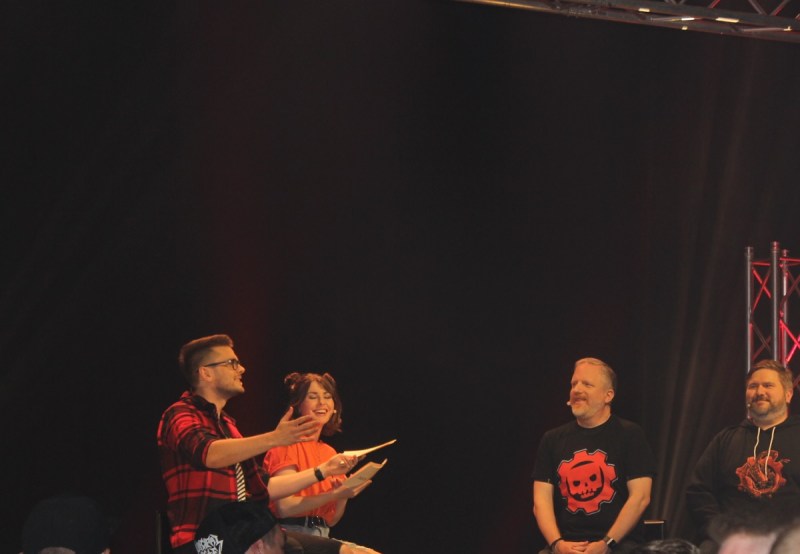
Above: Rod Fergusson, third from left, intervewed at Microsoft’s event at Gamescom in Germany.
GamesBeat: Was there a reason you didn’t want to use the Megamech again as a playable feature?
Fergusson: We’d done it in 4. It was just sort of — when we looked at where we were going to put our effort in, we wanted to create a new experience, rather than to re-create an experience you already had in 4. We decided to put more effort into the new thing. That’s not to say we won’t ever revisit it, because we know it’s a lot of fun. It’s just a bunch of work. When you have to change the scale of the world and create the ability to stomp through buildings and walk around in a city like King Kong, it’s a non-trivial amount of work. [laughs] We just have to look at where we use it. But I like having that in our world as something we can lean into.
GamesBeat: I actually had a harder time — I think I enjoyed the battle with the Matriarch more. You had to do more outwitting in that particular battle.
Fergusson: Yeah, having her running around with a lot more mobility is certainly a challenge. Being able to use the ice, freezing her, and working against her. Creating compelling large boss fights is always a challenge. It’s one of those things. We always have the notion of, what can we bring over to Horde? The Matriarch has to be a great boss fight in the campaign, but then also has to be a great boss fight in Horde. You have to develop it with both things in mind. Things like the Kraken can’t be that. You can’t do that in Horde. We can focus on where it’s going to be in the story.
GamesBeat: The Matriarch herself, what is her significance? I know that Kait said her headaches went away after the Matriarch was gone. I didn’t quite understand what role the Matriarch was playing there.
Fergusson: I’ll try to explain that. Basically, Myrrah’s connection to the Locust was done through this conduit — the Matriarch acted as an antenna for them. The way Niles was able to connect Myrrah to the Locust was through the Matriarch.
The hive mind is trying to take control of Kait and get her to come back. She’s the last living descendant of the queen’s line, so the hive mind is reaching out for her, and doing that is giving her these visions and nightmares. Niles tricks her into using the Matriarch as this antenna, to go into the hive mind and wake up her mom. Basically the Matriarch is a conduit to the hive mind for her. Once they kill the Matriarch, they turn off that antenna and sever her link to the hive mind.
GamesBeat: What are some of the different ways to level up Jack that you might choose, or that players might think as they’re building up their different capabilities in the game?
Fergusson: It comes down to play style. The big one is that every ability has four upgrades. Three of them can be unlocked through finding components throughout the world. What I like is we didn’t make it a tech tree. They weren’t dependent on each other. You can decide how you want to do it. Not everyone is going to look exactly the same. Plus you can respec. When you stack three and have a bunch more abilities, you can decide, “Oh, I don’t use this one anymore. I’ll clear out the points and apply it to the new thing I use a lot.”
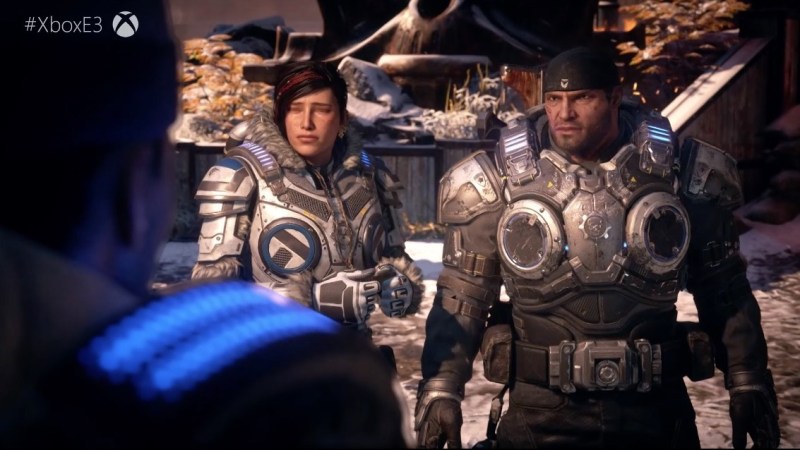
Above: Gears of War 5.
The biggest change — each ability has an ultimate. The way you get to Jack’s ultimates is by completing side missions or side quests. Even without any components, if you’re not finding anything to upgrade using components, you can still unlock these ultimate abilities. For example, one of my favorites is flash freeze. You have the basic ability to flash enemies — it stuns them and makes them stand up so you can headshot them, disorients them, that kind of thing — but when you go down a quest line in the ice level in act two, you get a freeze ability that adds to that flash.
Every time you flash something, it not only blinds and stuns them, but it also freezes them in place. That’s really useful, even in things like fighting the Matriarch. It means you can slow her down. You’re freezing her in the process. Going through and exploring — it’s a way of rewarding exploration and going down these different paths, not just staying on the main line. If you do these side quests, you’ll get a much stronger Jack out of it.
GamesBeat: Kait brings the diversity of the cast front and center this time. How did you guys think about diversity within the cast of this game?
Fergusson: It’s something we’ve been thinking about from the very beginning. It just changes slightly. When we first worked on Gears one, our diversity was about ethnic diversity. You have Cole and Dom and Marcus. Then, as we progressed, around Gears 3 we were also focused more on gender diversity. We brought Anya and Sam in as playable characters as well. We just continue to think like that.
Diversity attracts diversity, but it’s not something that just happens. If you’re not thinking about it, you’re probably not going to do it. We had to make conscious effort. Fahz was a conscious effort. We wanted to have a south Asian character in the game. When we had an opportunity to create a new character, we decided that’s the ethnicity we wanted, to add more diversity to the cast. It’s a conscious effort for us, and we’ll keep trying to do more and more.
Gears isn’t completely Star Trek. It’s not a utopian world. But we try to make sure we have what we want to put forward. It’s important to have that. Having representation in the game is important. You can try to do something too much and not succeed, so everything we try to do in Gears is to feel authentic. We want to be authentically diverse. We try to do it incrementally in a way that feels like it’s part of our world.
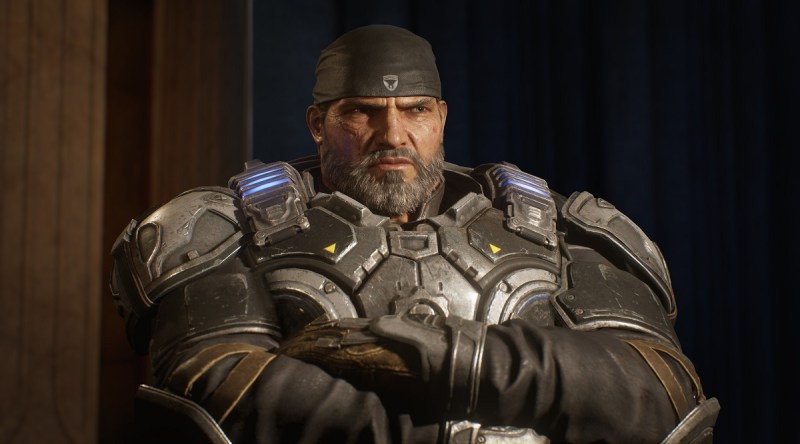
Above: Marcus Fenix is the star of the original Gears series, and he’s back in Gears 5.
GamesBeat: How did you think about bringing back these different characters like Baird and Paduk and Marcus? What roles did you want them to serve here?
Fergusson: We wanted to have the ties to the past. When we were talking about Gears 4, originally one of the random ideas was to take it to a different planet. What if we start Gears 4, since it’s a new thing, somewhere else and talk about a different planet instead of Sera? We didn’t do that because we felt we would lose our history. We’d lose the past and everything that came from the previous games.
That’s one of the things I like about having the old crew around, having Baird and Cole and Marcus around. They give us a tie to the past. It gives us an anchor to the previous trilogy without feeling like we’re doing the previous trilogy again. You get to carry all these lessons forward. The beloved characters get to make appearances and have an impact on the story. You’re not leaving them behind. But at the same time we’re also trying to carry forward new characters. You still want to be able to play as Kait, JD, and Del.
GamesBeat: I like that link to the past. But I also wonder, how many times can we destroy Sera?
Fergusson: Yeah, that’s a great question. War has officially returned. I think we’ll see how that’s going to play out. That was part of the thing in 4, when we introduced this idea that Sera herself, the planet itself, is fighting back and trying to rid itself of its inhabitants. The weather has turned terrible. There’s all these storms. We have to build wind walls around our communities to protect ourselves from the planet. There’s this idea of, if you mess with the planet enough, the planet’s going to fight back.
GamesBeat: I have this theory about Sera, that it’s hollow at the core. There’s no molten core. There’s plenty of room for swarms and Krakens and other things to live down there.
Fergusson: [laughs] That’s … a great theory.
GamesBeat: I got through about 68 percent of the campaign. What does that mean I left unplayed? There are a few side missions I know I didn’t play, but what else might have been unplayed if you finish the campaign at that percentage?
Fergusson: There are some points of interest, some combat with more upgrade for Jack, some technology. You probably didn’t find all the relic weapons. One thing we’ve added to the game — much like in Gears one, there’s the Crimson Omen that shows where a COG tag is hidden. There are 18 or so weapons we’ve put in the world. They’re Easter egg weapons, special one-of-a-kind weapons, that we’ve hidden near a Crimson Omen to give you a hint. It changes the gameplay and makes it a lot of fun. Now you have a sniper rifle that has two shots in the clip instead of one. That kind of thing.
You’re probably missing other collectibles that tell you about the story of the world. What was going on with the civil war in Vasgar? What was going on with Operation Hollow Storm in the ice level from act two? You’re probably missing some game experiences around side missions and points of interest.
GamesBeat: I killed 1,247 enemies over 15 hours, almost 16. It’s nice to know the stats.
Fergusson: We like to have a good K/D ratio in our campaigns. We like to have stories with lots of action.
GamesBeat: Shakespeare plays are supposed to be five acts. I was kind of waiting for the fifth act to come up. You only had four.
Fergusson: Yeah, historically we’ve had five. Acts two and three are so ginormous. We looked at bookending that. Act one is almost a prologue, building you up going into the ice level and the sand level, these two large acts. Then when we got to the point where we said, “Okay, we have the Hammer of Dawn now” — it’s one of those things we always try to do in Gears. When you’re riding a horse back to the barn it picks up speed. That was the way we thought about act four. Okay, now we’re heading back to the barn. Let’s pick up some speed. It felt natural to end it there.
GamesBeat: We lost some main characters here, some big characters. How did you think about that, the way that worked in the story?
Fergusson: Our big thing for this game was challenging expectations through player choice. We’ve never had this kind of choice before in a Gears game, where you can affect who lives and who dies. We wanted to put it at a place where it made sense. If you do it too early, we’d have to almost make two different games. We wanted to make sure it was at a place where we could support the decision content-wise, but also we wanted to make sure that you spent enough time with both of them.
I’m really curious to see how all that plays out and what that means for the world going forward. We haven’t decided yet. But at least in the short term, we wanted to have that experience. Did you play BioShock Infinite?
GamesBeat: Yeah, definitely.
Fergusson: Do you remember the lottery scene, where you have the baseball and you decide whether to throw it at the couple or throw it at the guy? That kind of decision — that was one of the things that resonated with me. Giving the player a hard choice and having them decide how to deal with a situation. What does this mean? I liked that idea. That was part of the inspiration behind this choice. Let’s give the player an impossible choice and see what they do with it.
GamesBeat: It made the game more serious. I always think of Gears as a combination of the wackiness in some of the combat, and then the serious tone of the story. It’s a losing battle. How do you think about that contrast? How serious to make it versus how crazy?
Fergusson: We always oscillate across all that. It’s one thing I love about the franchise. If you look at the spectrum, you can go all the way from over-the-top comically funny to summer blockbuster action movie to emotional moments that make you cry, like the Dom scene or the Maria scene. I love having a franchise where you have permission to go anywhere with it. You can almost take it anywhere. You’re not locked in.
We wanted this to be about war. We wanted this to be about loss. We wanted to make sure that along the way, you lost people. That was part of it. We felt like this was the time to shake things up and make people, like I said, feel that loss. We wanted you to hate the queen out of the gate. We wanted to make you understand that she’s not Kait’s mom. We didn’t want you to think you could save her. We didn’t want it to be, “My mom’s inside. We can save her. We have to help her, not fight her.” By having the queen kill a beloved character, now you hate her. You want to fight her. That was something we wanted to underline right away. It’s not Reyna. It’s the queen. You need to kill it.
GamesBeat: It feels like Gears is aging, and some of your players are too. Maybe they appreciate some more serious storytelling. I don’t know if that matters as well, that there’s this older generation of Gears players now. Maybe they’re more into the storytelling side.
Fergusson: Yeah, I agree. I just don’t want to lose all the humor. I feel like being in a post-apocalyptic world where it’s all grim — if all the way through Gears 4, Kait just said, “But my mom, but my mom, we gotta save my mom,” in a single tone — in an oppressive world you can end up there if you let yourself. Having that gallows humor, having some moments of levity, that kind of thing helps. You want to have a peak and valley kind of experience. Having a joke in one scene gives you permission to have a really serious moment somewhere else. The contrast makes it more impactful.
GamesBeat: You’ve got more humor than The Last of Us. That’s a good thing.
Fergusson: [laughs] Yeah, I’ll take that.
